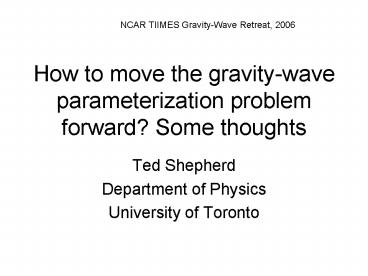How to move the gravitywave parameterization problem forward Some thoughts
1 / 16
Title:
How to move the gravitywave parameterization problem forward Some thoughts
Description:
University of Toronto. NCAR TIIMES Gravity-Wave Retreat, 2006. Observations ... of GW parameterizations that matter the most for weather and climate simulation ... –
Number of Views:30
Avg rating:3.0/5.0
Title: How to move the gravitywave parameterization problem forward Some thoughts
1
How to move the gravity-wave parameterization
problem forward? Some thoughts
NCAR TIIMES Gravity-Wave Retreat, 2006
- Ted Shepherd
- Department of Physics
- University of Toronto
2
Observations
3
- The first principles approach (Tim)
- Need to test parameterizations against highly
resolved simulations - Need to get reasonable results with reasonable
parameters - Need to know that sensitivity to climate
perturbations is realistic - Filtering effects are probably robust
- Source changes are more of a challenge
- The users approach.
4
- We need to identify the aspects of GW
parameterizations that matter the most for
weather and climate simulation - Despite the number of different parameterizations
and the intensity of debate between some of
their proponents the choice of parameterization
seems not to matter greatly - However most comparisons have not been
well-constrained
5
- Once the source spectrum is constrained, the only
important parameter seems to be intermittency
(McLandress Scinocca 2005 JAS) - Determines the breaking height
- This is not very surprising, in light of
downward control - Some assumptions
- CLs always absorb
- CLs always reflect
- No horizontal propagation
6
- The partitioning between nonlinear drag and
critical-level drag depends on the scheme, but
the net drag is the same
From McLandress Scinocca (2005)
7
In an active GCM such as CMAM, one can actually
rely on critical-layer drag alone! But if the
drag only sees the zonal-mean wind, then one
needs nonlinear drag
8
- Instantaneous snapshot of SKYHI
- zonal winds for various altitudes,
- during a model July
- Increasing gravity-wave activity
- with increasing altitude
From Koshyk et al. (1999 JGR)
9
Horizontal wavenumber spectra (n spherical
harmonic index) of kinetic energy for SKYHI and
CMAM Straight lines show -3 and -5/3
slopes Charney-Drazin filtering is
evident Shallow spectra emerge with increasing
altitude Figure courtesy of John Koshyk
10
- This all confirms the suspicion that many have
had for a long time that the key issue is the
source spectrum, and perhaps to a lesser extent
intermittency - However it is also essential that
parameterizations are implemented in a
momentum-conserving way, and that there is no
Rayleigh drag or zonal-mean sponge layer (Shaw
Shepherd JAS, in press) otherwise robustness is
lost - Remarkably, this is far from the case with
climate models!
11
- From the modelling side, we need to identify
where it is that gravity wave parameterization is
most important (for either climate or climate
change), and assess the robustness of different
model results in this respect - Polar vortex, esp. in the SH
- Summer mesopause
- MLT more generally difficult
- Tropical upwelling
- SAO and QBO difficult
12
- First we need to identify the principal
climate-change uncertainties associated with
gravity-wave drag (insisting on momentum
conservation!) - SPARC CCMVal is a good framework for this
- And then we need to develop a better
understanding of the sensitivities in
well-constrained comparisons - Emerging SPARC initiative on dynamical processes
should provide a good framework
13
- Development of physically-based source
parameterizations (which respond to climate
change) is a very positive step - We need to assess their sensitivity (e.g. to
climate variations) and identify their role in
the simulations - Impact of changes in sources vs impact of changes
in GW filtering - Its not obvious that a predicted change in the
source is better than no change!
14
- In the extratropics, middle atmosphere data
assimilation should provide very useful
constraints on GWD - Planetary waves and zonal winds in the
troposphere and stratosphere should be about
right, hence the filtering of GW fluxes - This will also slave the large-scale mesospheric
fields to a large extent - Increments from temperature observations will
likely mainly reflect errors in GWD
15
- In principle, if GW parameters are a control
variable in the data assimilation, then they can
be constrained by the temperature observations - This is a developing theme within the SPARC Data
Assimilation Working Group - Can one use an instrument forward model
off-line, acting on the parameterized GW
spectrum, to predict GW variances observed by
satellites? - Would likely need to be statistical
16
- The large volume of satellite data relevant to
GWs raises the prospect of performing reasonable
statistical tests - Intermittency
- Sensitivity of sources to local conditions
- But how much of a constraint do these satellite
observations place on the part of the GW spectrum
that matters? - Need to relate what the satellites measure to
the full spectrum (via mesoscale models, field
experiments), and use the satellites to
extrapolate to global fields































